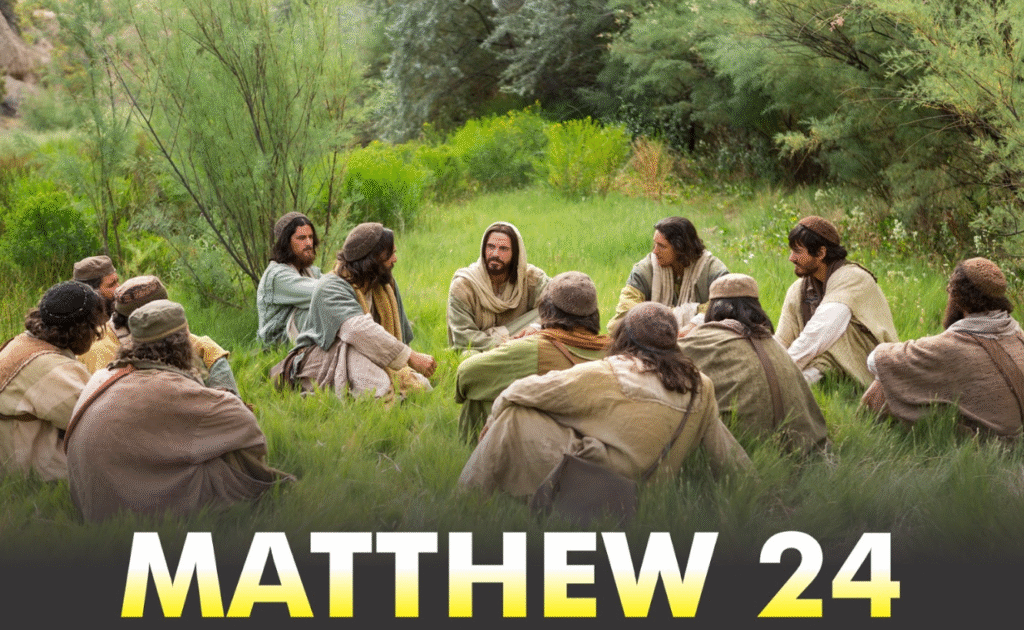BOOK: EXCERPT: The Rapture will be canceled – Chapter Seven

By Niklas Arthur © 2014
Matthew 24 Exposed
Matthew chapter twenty-four is perhaps one of the most misunderstood prophetic passages in the Bible.
Jesus disciples are showing him the buildings of the temple and Jesus prophesies their destruction:
“See ye not all these things…there shall not be left here one stone upon another…”
Matthew records two questions asked of Jesus’ disciples when they reach the Mount of Olives.
The first question is differentiated by the phrase, “these things” and the author uses this key throughout the text to separate the two answers.
I have highlighted the first question and its direct answers in yellow-round box, the second in blue-square box.
“These things” also begs the question, what things?
The answer is in the previous verse, the “buildings of the temple”.
The buildings of the temple were standing when Jesus was there.
This does not include the outer wall or retaining stones of the Temple Mount itself.
Jesus knew what was going to happen:
in 70 AD the Romans burned the Temple and all of the gold overlay melted and seeped between the stones of the Temple itself so that the Roman soldiers turned over every stone of the buildings to extract that gold, completely fulfilling Jesus’ prophecy to the letter.
Question #1:
when shall these things be? In other words, when shall there not be left here one stone upon another of the (antecedent) buildings of the temple?
Question #2:
what shall be the sign of thy coming, and of the end of the world?
Jesus and his disciples are leaving the temple mount where Jesus briefly comments on the coming destruction of the buildings there.
After they travel the short distance to the mount of Olives they engage in a private conference where the two question are asked.
In verses 15 through 22, Jesus directly answers the first question in relation to events including the annihilation of Judea, the Temple and the Hebrew Nation, culminating in the 70 AD desolation by addressing the disciples directly,
“ye therefore shall see…”
then he broadens the scope to
“them which be in Judaea”
with instructions to follow the signs for that generation.
You will notice that the text only includes us parenthetically, (whoso readeth…).
If we were included with those who would see the “abomination of desolation”, Then the text would have been stated,
“whoso or whosoever shall see”
This is a major distinction of the Authorized King James Version of the bible:
The translators worked vigorously to only present a word for word translation from the original Greek, whereas most modern versions attempt to interpret the text for you– but whose interpretation are they giving you but their own, and that is decidedly Futurist.
THE AUTHORIZED BIBLE: KING JAMES VERSION (KJV) – Library of Rickandria
Jesus then in a very conversational mode broaches general instruction for the entire last days era in verses 4-14 and 23-26.
In these sections Jesus expresses conditions that are applicable to the entire end times, including the time from his ascension until he returns.
These are more of a warning and instructional in quality as an addendum to the subject questions, and not specific to either question, therefore I have not highlighted those.
Jesus then closes this section (v.22) with a promise that the tribulation of that time, which they would see, would be shortened because it was necessary for the elect to survive to preach the Gospel of the Kingdom to the world.
Remember that the first century Christians were a sect of the Hebrew religion which was experiencing the wrath of the Roman Empire.
This is why Jesus instructed His followers to flee Jerusalem and Judea.
Many try to apply v.22 to the days preceding the Return of Christ, but it is not necessary for the elect to survive through His return because we will all be resurrected at that time, not to mention that the Revelation explicitly states that many will suffer beheading for rejecting the Mark of the Beast.
In verses 27-31 the conversation wanders to specifically address some points of the second question about his return and the end of the world, then back to the general in verses 32 and 33.
Jesus then wraps up question #1 in verse 34 before he continues to finish the topics of question #2.
One key is in the term “these things” from the Strong’s Greek 5023.
When searched for occurrences of the G5023 I find a universal indication to things present, or we could say “these present things” but never is it used to reference things far off or belonging to a future generation.
This rule of grammar is followed very closely in this chapter as indicated by the introduction of “these things” in the first question and its inclusion in the answer specific to “This generation”, also the exclusion of the phrase in the second question and all of those things which are specifically ascribed to Jesus’ return and the end of the world.
This understanding when applied should clear up all the confusion from the text, at the same time controvert most of the popular futurist eschatology and interpretation of this passage.
When applied we should be able to rightly divide this passage of text to gain a clear understanding without conjecture or other added presupposition.
Matthew was a firsthand witness upon this occasion, the parallel passage in Luke is a hearsay account therefore can only be used to verify Matthew.
The Historical Grammatical method requires us to give Matthew’s account primary weight in interpretation.
CONTINUE
BOOK: EXCERPT: The Rapture will be canceled – Chapter Eight – Library of Rickandria
BOOK: The Rapture will be canceled – Library of Rickandria
